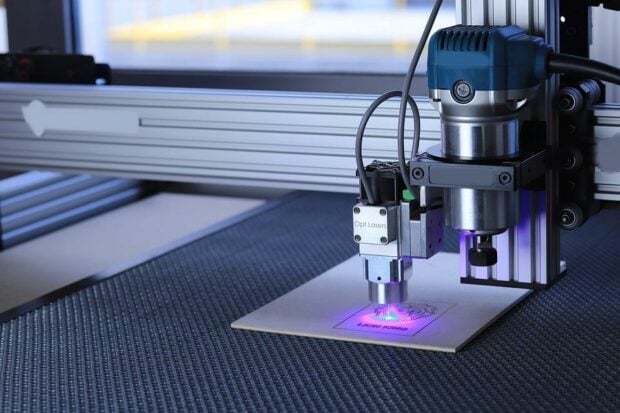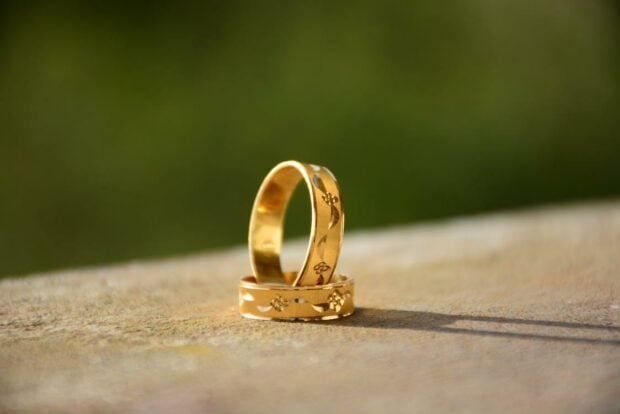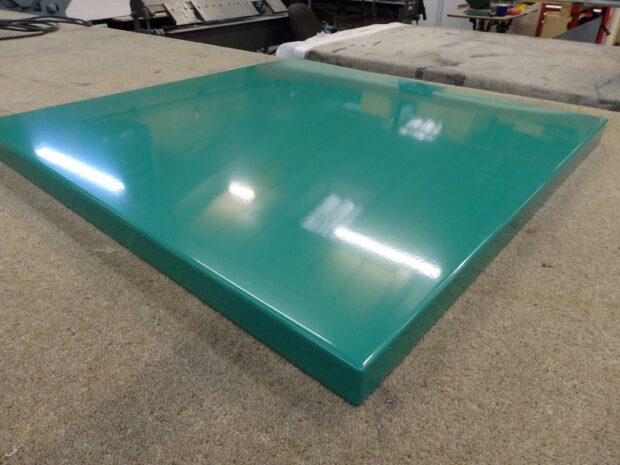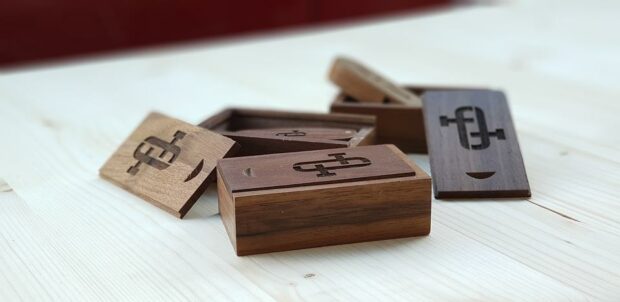Laser engraving is the fastest and most long-lasting way to mark a material’s surface. It’s great for gifts, industrial designs, and so much more. However, what is laser engraving, and how does it work?
Businesses and automotive companies commonly use engravers for their products. However, you might have also seen their finished products on personalized pens or tumblers.
Laser engraving has an interesting process for achieving the permanent marks we see on surfaces.
Here’s a comprehensive guide on everything you need to know about what laser engraving is and how it works.
What Is Laser Engraving?

The way we’ve marked surfaces has changed, from the old printing press to the large laser etching and engraving machines we have today.
Laser engraving is the fast process of using powerful laser beams to cut or engrave a hard material. These light waves vaporize a part of the material surface to have the laser engrave your design.
It results in high-contrast laser dark marking, easily visible to the naked eye.
This process has been used by different industries — from simple daily items to complex technologies like aerospace parts.
We’ll discuss later how you can use laser engraving for different products.
How Do Laser Engraving Machines Work?
Laser engraving relies on the vaporization temperature of your laser light to change a solid to a gas without turning it into a liquid. This process is technically known as sublimation.
The laser beam touches the surface of the material, which is absorbed. Depending on your design, it results in crevices that can form an image or words.
You can easily adapt the process to fit specific applications and materials.
Engravers are powerful machines that come with safety instructions to ensure that any chemical reaction won’t cause great harm to the user.
However, the laser engraving process can produce toxic fumes from high vaporization temperatures. The machine should have a reliable fume extraction system to properly store these harmful gasses.
What Can I Make With a Laser Engraving Machine?

The laser engraving process has many uses, from labeling and personalizing an item to designing a surface.
Using this machine, you can easily achieve the following laser-engraved products:
- Customized objects – This is the most common way of using a laser engraver. It can engrave electronic gadgets, tumblers, glass, bottles, belts, jewelry, clothes, and more.
- Identification marks – These can be used to engrave barcodes, QR codes, logos, and other identifying marks to identify the owner.
- Decorative items – Use an engraver to create art pieces like wall hangings, vases, and more. These can be used as personalized gifts for your loved ones.
- DIY projects – You can also use an engraver to design and create almost all objects from steel, wood, and other materials.
What Are the Different Materials That Can Be Laser Engraved?
A laser engraving machine is compatible with various materials.
Remember to consider your material surface to successfully do the engraving process. Some lasers work better with specific surfaces or can cause harm to others.
1. Plastics
Plastics, such as acrylic and POM, are commonly used for laser engraving projects.
When working with plastic, your machine’s vaporization temperature depends on the absorption of your material.
When adjusting your machine’s settings, you must consider the plastic’s melting point and its make up, since it can greatly affect your end product and safety.
The melting point is affected by other additives as well. Check if your plastics have colorants, retardants, or release agents, which can affect your process.
It’s best to use CO2 or UV laser machines for this material.
2. Wood
Source: Pixabay
Using a laser engraver on wood may sound like a fire hazard because of the high heat. However, there’s a way for machines to go around that.
The best wood engraver would use a weak light or low-temperature laser beam to create high-quality markings without the wood catching fire.
This process can be done to hardwood and softwood. However, it’s best to use non-porous woods for this job, like plywood, MDF, and cardboard.
3. Metals
Source: John Rutter
Metal engraving is one of the most common processes. It usually deals with different alloys, making it useful for different industries.
The most compatible metals for this process are steel, iron, gold, silver, and aluminum. The wide range of materials you can work with makes it great for different businesses.
Using a fiber laser is best for this material.
4. Coated Metals

Coated metals are a special case when it comes to laser engraving.
The laser engraving process of this material leads to a clean removal of its surface coating before it can engrave the actual metal.
What Are the Kinds of Laser Engraving Machines?
There’s more than one type of laser machine in this industry. Each machine is great with specific materials, as previously stated.
Here are the different laser engraving systems and what they’re best used for:
1. CO2 or Gas Lasers
These lasers are commonly used for homes and small businesses. It works by running electricity through a gas-filled tube and different gasses.
CO2 lasers usually range from 25 W to 100 W, making them great for non-metallic and organic materials. They’re usually used for wood, glass, plastics, ceramics, etc.
While effective, it also comes with expensive maintenance and operational costs. It can also greatly impact your electricity bill because of how much energy it consumes.
2. UV Lasers
These machines use UV rays to engrave your designs onto your material. It uses about a 355 mm wavelength to create these designs.
These machines are special because they don’t produce heat during engraving. As such, their lasers are compatible with materials with a low thermal threshold.
They’re commonly used for engraving on the surfaces of electronics, microchips, and circuit boards.
The downside of these lasers is their limitations. They’re only used on metals because of their low power level and how it produces low heat.
3. Fiber Lasers
These lasers are powerful, usually ranging from 20 to 50 watts. The wide range can have the machine’s laser cut various materials.
Its versatility makes it one of the most popular marking machines in the industry.
The filtration of monochromatic beams results in fine and detailed images on the material’s surface. Those beams are durable, flexible, and suitable for different surfaces, no matter how complex.
Fiber lasers are also not restricted to engraving. You can also use it for laser etching, which produces a raised mark on your surface.
Note that this type of laser is not compatible with thick and reflective surfaces.
4. Crystal Laser Cutters and Engravers
Crystal laser cutters and engravers are commonly used for 3D projects and industrial use. They are more expensive than the average engravers used at home or by hobbyists.
Its high-powered lasers generate beams from nd: YAG (neodymium-doped yttrium aluminum garnet) and nd: YVO (neodymium-doped yttrium orthovanadate) crystals.
Special crystals are used to simplify those difficult terms to engrave the intricate designs we commonly see on bigger products, like tumblers, glasses, and more.
They’re best used for plastics and coated and non-coated metals.
What Software Programs Can Be Used to Create Vector Files?
There are plenty of excellent software programs you can use.
Here are just some of the best software programs you can check out:
1. Adobe Illustrator
Adobe is probably a familiar name to you. While it’s not famous for laser engraving, it’s actually great software for creating your designs for the engraving process.
You can use it for both Mac and Microsoft. You can even use it on your iPad. You can easily create your designs using an Apple pencil as if you were sketching on paper.
Numerous tutorials can help you learn how to make the most of the program. You can also connect it to other Adobe programs, such as Photoshop and InDesign.
Export your files as AI, DWG, PDF, EPS, DXF, or SVG — which are usually compatible with laser engravers.
However, the major downside of this software is its subscription program. While you can get a 7-day free trial, it will cost a minimum of $20.99 a month. Additional Adobe apps may raise their price too.
2. Inkscape
Inkscape is a well-known software that offers a free program for designing. It includes many options you can use for your design process.
Thanks to its simple features and extensive design tools, it’s one of the most beginner-friendly programs.
It also allows you to communicate with other users, letting you learn from fellow designers in the community.
This program is available on Mac OS X, Linux, and Windows, making it accessible to everyone.
3. LightBurn

LightBurn is a program created specifically for laser engraving files. It supports various image formats and vector graphics, such as PNG, JPG, AI, PDF, and more.
You can easily use the program for your designs and send them directly to the machine. Easily create new vector shapes, edit, and arrange them to your preference!
This software is available for a 30-day trial before you would have to purchase its license. You can download it on Mac iOS, Windows, and Linux devices.
What Are the Advantages and Disadvantages of Laser Engraving?
Laser marking and engraving are just one of the many ways to alter the surface of the material you’re working with.
However, this process does come with its advantages and disadvantages. You’ll have to consider them when working with a laser engraving machine.
Advantages
There’s a reason why some people prefer to use laser engraving over traditional methods or other machines for marking surfaces.
These are the advantages of laser engraving:
1. Precision and Durability of Laser Marking
Laser engraving machines are known for their high precision and accuracy. Most machines can laser engrave thin lines up to +/- 0.01 inches wide.
These deep marks are permanent due to the laser coloration and vaporization temperature. Environmental factors and the like do not damage them compared to other engraving methods.
These features allow them to easily engrave a barcode or QR codes onto various surfaces. They’re also great for creating intricate designs on small pieces like jewelry, medical tools, or electronic parts.
2. Fast and Repeatable Process
This engraving method is great for the rapid manufacturing of merchandise and other products.
You can complete the whole laser cutting or engraving process in minutes, depending on your design, laser power, and the material you’re engraving on.
Software used for laser cutting can also store data and settings about your design. It includes data on your material’s melting point, the small changes to your design, and more.
You can easily create identical and high-quality marks on similar surfaces or different parts.
The repeatability of its process lets you produce everything a lot faster compared to any other laser.
3. Compatibility with Many Materials
Laser engraving works with different materials.
You can easily customize plastic, wood, metal, and much more with just one laser engraving machine.
On the other hand, other engraving machines can’t do this.
An example would be how chemical etching can do wonders with metal. However, they can’t accommodate other surfaces.
If you’re looking to start a business with laser-engraved products, you can easily find a machine that can handle different surfaces and materials.
4. Eco-Friendly Marking Process
Compared to other engravers, a laser engraver doesn’t require many consumables to do its job. Some can require chemicals that contribute to pollution.
It also doesn’t make much noise during the laser marking process.
It helps lessen waste and noise pollution while creating a creative and long-lasting mark on various items.
Disadvantages
While there may be many positives to working with laser engraving technology, it also has its downsides.
Here are the disadvantages of laser engraving:
1. Cost for Operation and Maintenance
It’s no secret that even the simplest lasers can be expensive. Most machines would need extra accessories or parts, depending on the projects you’re working on.
It’s also expensive to maintain and operate your machine. You would have to consider its energy consumption and the condition of each part on top of creating your designs and products.
Every additional accessory would cost extra just to change the capabilities of your machine. If you’re switching materials or approaches in engraving, you might have to tweak some of its parts.
If you’re considering investing in an engraving machine, you’ll have to take note of these additional costs and can sustain them.
2. Dangerous Fumes
While laser engraving does lessen its effects on the environment, its sublimation process can still have a by-product from vaporizing a solid material.
When your material reaches its melting point, it releases dangerous gas and fumes as a chemical reaction from laser light.
These gasses can be extremely dangerous for anyone. As such, you’ll need good ventilation and a system to store these fumes to create a safe working environment.
Some engraving machines have additional accessories that can help lessen the risk of these fumes. However, you would need to pay for those as well.
3. Usually Needs Expertise
There are many beginner-friendly laser engraving machines on the market, especially if you’re just starting to get into laser engraved items.
However, to start a business or work on this hobby, you would need a certain amount of expertise to not waste your resources.
You might need a specialist operator to have your machine perform to its potential. They’re also guaranteed to provide high-quality results.
Hiring someone with expertise or taking lessons for yourself would cost extra. The latter would also need time to develop.
Your expertise also determines the quality of your markings. Your products will improve the more experience and knowledge you have with engraving.

Frequently Asked Questions
You may have more questions about laser engraving and its processes.
We’ve gathered the commonly asked questions to help you further understand how they work:
What’s the Difference Between Laser Engraving and Laser Marking?
The main difference between laser engraving and laser marking is their lens.
Laser marking is the umbrella term that includes processes like laser etching and laser engraving.
Laser marking creates high-contrast markings on different parts of the surface with laser power. It includes different processes, such as laser etching, ablation, engraving, and annealing.
Laser etching process and laser engraving are also terms that are commonly interchanged in the laser marking industry. However, each process is different.
The laser etching process uses a laser-powered machine to melt and raise the object’s surface, creating a more shallow mark.
On the other hand, the engraving process removes a large part of the material to create intricate designs.
How Long Does Laser Engraving Take?
Laser engraving involves many factors and processes which can affect its production time.
It can stretch from a few seconds to hours. It depends on the details of your design, your material, and the power of your laser beams.
Does Laser Engraving Leave Permanent Markings?
Yes, they leave permanent markings on the surface of the material you’re working on.
The main purpose of the laser engraving process is to have the laser beam create deep crevices and discolor specific parts of your material. The product doesn’t damage the integrity of the whole material itself.
Can I Make Money With Laser Engraving?
Yes, you can make money with your laser engraving work.
In fact, there is a huge demand for custom engraving for labeling or marking goods. All you’ll need is a laser engraver and the items you will be engraving.
The best part of this business is that lasers can work on multiple kinds of materials. Whether it’s wood, metal, or glass engraving, you can easily work with them using the best laser engravers
Conclusion
Many industries use laser engraving for many reasons. It’s proven to be versatile and a great way to leave a mark on important items in our lives.
Laser engravers are reliable tools for many crafts — whether using them to engrave barcodes for identification purposes or to decorate your material.


